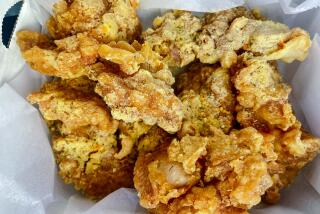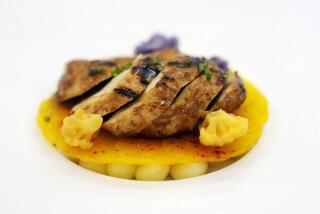What goes into chicken
- Share via
When you go to the market and buy a raw apple, you expect -- and get -- an apple. Not a fruitlike product injected with liquid that makes it weigh more but that softens the natural crispness and dilutes the flavor to the point where it has to be infused with caramel-apple concentrate to restore some tastiness. Fortunately, Fujis are still Fujis. If only the same could be said of chicken.
In the past few years, it has become common for chicken producers to inject fresh chicken with saltwater as a way to keep it juicy and flavorful in the hands of indifferent cooks, a process called “enhancing” or “plumping.” In some cases, the plumping solution contains a long list of ingredients, and it can make up a fifth or even more of the chicken’s weight. The results can be culinarily strange: chicken with a smooth, synthetic texture like Spam, and a salty or sometimes acrid flavor. Not to mention a higher sodium content, which many people are supposed to avoid for health reasons.
According to Kenneth McMillin, a professor of meat science at Louisiana State University, plumping of some kind or another has been around a long time, but has gained popularity in the last three or four years. When growers bred chickens for higher meat production -- more muscle, less fat -- they also brought a dry, less tasty bird into the market. Overcooked, it could be nearly inedible. Besides, chicken that’s nearly a fifth water is much cheaper to produce. That’s how we’ve ended up buying chicken with enhanced breasts (and everything else).
The tinkering didn’t end there. McMillin reports that the saline injections reached such high percentages that much of the chicken flavor was lost, so “natural flavor” was added, usually in the form of a concentrated broth, along with corn syrup or other forms of sugar and lemon concentrates. Phosphates are commonly added as a binder, to help the meat retain the water and salt during shipping and cooking. Usually this is sodium phosphate. But then dietitians complained that the plumping of chicken was also pumping up the sodium levels of a naturally low-sodium food. In response, a few producers switched to potassium phosphate. That gives the meat a bitter taste, thus encouraging the addition of more flavorings to mask it. All these additives can overwhelm any herbs and spices a cook might use.
As long as the ingredients in the injected solution can legally be labeled natural, so can the chicken. The only tipoff is in the small print informing consumers about the ingredients of the plumping potion and how much of it is in the chicken. A package of chicken thighs sold in local markets announces, in almost unnoticeable lettering, that the meat has been enhanced “up to 18%” with water, salt, lemon juice solids, natural lemon flavor, cane juice, corn syrup and other natural flavorings. A shopper who buys this $6 package of chicken is thus paying more than a dollar of that for a complicated salt-and-sugar-water solution.
It’s not entirely fair to single out chicken. According to McMillin, most pork sold in this country is plumped, and about a third of the beef. But the producers of these meats have brought a level of finesse to the process, tailoring the type and amount of added liquid to the specific cut of meat so that the results are more, well, meaty.
Some people might prefer the salty, gelatinous chicken, just as some prefer sugared “juice drinks” to plain fruit juice. But at least the beverage consumers know what they’re getting. The drinks can’t be labeled as juice; the wording usually notes that they contain a small percentage of “real fruit juice.” Foster Farms, which developed an entire marketing campaign around the fact that it does not plump its chicken, is calling on the U.S. Department of Agriculture to withhold the “all natural” label from enhanced chicken.
Although we hate to take sides in corporate competition, we think Foster Farms is right. If anything, its campaign is too tame. It’s tempting to imagine a label that identifies heavily enhanced chicken as “chicken-like product, with X% real chicken.” At the very least, enhanced meats should be conspicuously labeled as such, and the list of added ingredients should appear in larger type. Shoppers should know at a glance what they’re really getting.


